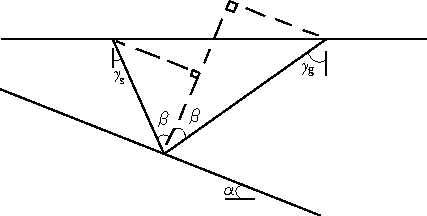




Next: Snell-wave stacks and CMP
Up: THE MEANING OF THE
Previous: Various meanings of H
A tendency exists to associate the sine of
the earth dip angle with Y and
the sine of the shot-geophone offset angle with H.
While this is roughly valid, there is an important correction.
Consider the dipping bed shown in Figure 30.
clay
Figure 30
Geometry of a dipping bed.
The line bisecting the angle  does
not pass through the midpoint between g and s.
(Clayton) does
not pass through the midpoint between g and s.
(Clayton)
|
|  |

The dip angle of the reflector is  , and the offset is
expressed as the offset angle
, and the offset is
expressed as the offset angle  .Clayton showed, and it will be verified, that
.Clayton showed, and it will be verified, that
|  |
(65) |
| (66) |
For small positive or negative angles the cosines can be ignored, and
it is then correct to associate the sine of the earth dip angle with Y
and the sine of the offset angle with H.
At moderate angles the cosine correction is required.
At angles exceeding 45 the sensitivities reverse, and
conventional wisdom is exactly opposite to the truth.
The reader should be wary of informal discussions
that simply associate Y with dip and H with velocity.
``Larner's streaks''
were an example
of mixing the effects of dip and offset.
Indeed, at steep dips the usual procedure of
using H to determine velocity
should be changed somehow to use Y.
the sensitivities reverse, and
conventional wisdom is exactly opposite to the truth.
The reader should be wary of informal discussions
that simply associate Y with dip and H with velocity.
``Larner's streaks''
were an example
of mixing the effects of dip and offset.
Indeed, at steep dips the usual procedure of
using H to determine velocity
should be changed somehow to use Y.
Next, (65) and (66) will be proven.
The source takeoff angle is  , and the incident
receiver angle is
, and the incident
receiver angle is  .First, relate
.First, relate  and
and  to
to  and
and  .Adding up the angles of the smaller constructed triangle gives
.Adding up the angles of the smaller constructed triangle gives
|  |
|
| (67) |
Adding up the angles around the larger triangle gives
|  |
(68) |
To associate the angles at depth,  and
and  , with
the stepouts dt/ds and dt/dg at the earth's surface
requires taking care with the signs,
noting that travel time increases as the geophone moves right
and decreases as the shot moves right.
Recall from equations (46), (47),
(49), (50), (51) and (52),
the definitions of apparent angles Y and H,
, with
the stepouts dt/ds and dt/dg at the earth's surface
requires taking care with the signs,
noting that travel time increases as the geophone moves right
and decreases as the shot moves right.
Recall from equations (46), (47),
(49), (50), (51) and (52),
the definitions of apparent angles Y and H,
|  |
(69) |
| (70) |
Adding and subtracting this pair of equations
and using the angle sum formula from trigonometry
gives Clayton's cosine corrections (8):
|  |
(71) |
| (72) |





Next: Snell-wave stacks and CMP
Up: THE MEANING OF THE
Previous: Various meanings of H
Stanford Exploration Project
10/31/1997


![]() , and the offset is
expressed as the offset angle
, and the offset is
expressed as the offset angle ![]() .Clayton showed, and it will be verified, that
.Clayton showed, and it will be verified, that
![]() the sensitivities reverse, and
conventional wisdom is exactly opposite to the truth.
The reader should be wary of informal discussions
that simply associate Y with dip and H with velocity.
``Larner's streaks''
were an example
of mixing the effects of dip and offset.
Indeed, at steep dips the usual procedure of
using H to determine velocity
should be changed somehow to use Y.
the sensitivities reverse, and
conventional wisdom is exactly opposite to the truth.
The reader should be wary of informal discussions
that simply associate Y with dip and H with velocity.
``Larner's streaks''
were an example
of mixing the effects of dip and offset.
Indeed, at steep dips the usual procedure of
using H to determine velocity
should be changed somehow to use Y.
![]() , and the incident
receiver angle is
, and the incident
receiver angle is ![]() .First, relate
.First, relate ![]() and
and ![]() to
to ![]() and
and ![]() .Adding up the angles of the smaller constructed triangle gives
.Adding up the angles of the smaller constructed triangle gives


